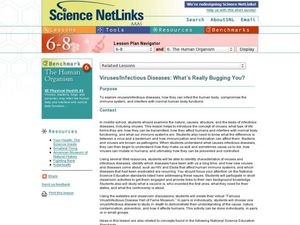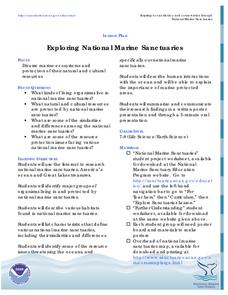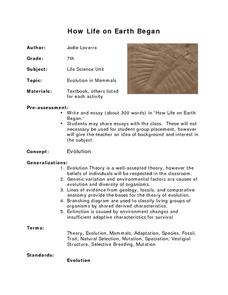K20 LEARN
It's Alive! Or, Is It?
Seems like a fairly simple question—until you begin asking your class! Get pupils acquainted with the characteristics of life through pairs classification, discussion, and scientific reading. The lesson plan, part of the K20 series, also...
Alabama Wildlife Federation
Butterflies without Borders
Some living things go to extreme measures to avoid the cold. A three-part activity guides learners through the migration of the monarch butterfly. After studying the life cycle of the monarch butterfly, pupils learn the process of...
Aquarium of the Pacific
Kelp Forest Habitat
What forest is in the ocean? The class watches a video that introduces the kelp forest and the parts of kelp. Learners dive into the ocean and see what different species live near the canopy, the midwater, and the bottom of the kelp...
American Museum of Natural History
Ocean Creature Feature
From coloring to hard protective shells, ocean creatures have adaptation features that help them survive. An eight-question online quiz highlights different ocean animals and their unique characteristics. The resource then offers pop-up...
Exploratorium
Life Size - Explore the Size and Scale of Microscopic Biology
Compare sizes of microscopic items. Given a set of labels of microscopic objects, pupils try to place them in order from smallest to largest. Scholars then compare their lists to the actual comparisons along with the measurements of the...
Nature Works Everywhere
Fishing for a Future
Teaching a man to fish has an environmental impact. Through a series of four lessons, learners study the science of fishery management. Their study involves analyzing data to develop a management strategy for specific fish and common...
Purdue University
Food Waste and the Environment
Out of sight out of mind can be a dangerous habit. Learners investigate the life of food waste after it leaves people's homes and its impact on the environment. They complete a series of three activities that involve building a mini...
Curated OER
Wildlife
The centerpiece of this lesson plan is a predator-prey simulation in which colored paperclips represent different species of animals camouflaged against a colored background. Relevant follow-up questions are provided. The activity is...
Curated OER
Plant Life Cycle: Quiz Game
Play the game, Who Wants to be a Millionaire? to review plant parts, life cycle, and pollination. There are 10 questions that get kids thinking about seeds, seed dispersal, pollination, and plant parts. This game is has audio and looks...
Foundation for Water & Energy Education
How Can a Dam Affect a River? Activity A
Written for Washington state students in life science, this lesson provides an opportunity to examine the residents of local freshwater habitats. You or the class collects a water sample, and learners try to examine what organisms live...
Curated OER
Viruses/Infectious Diseases: What's Really Bugging You?
Middle school life science or health classes listen to an audio, visit websites, read different articles, and participate in a class-wide simulation about the spread of viruses. The lesson doesn't get into the mechanics of how viruses...
Mr. Jones's Science Class
Periodic Table Project
Don't be fooled by the title; this is not really a lesson on elements. It is a project on classification, using the periodic table as an example. For that reason, it could be used in any branch of science. As an example, a group may...
Curated OER
Facts on Fish Species
Here is a brief outline of facts on various Chesapeake Bay fish species. Use it as an example of what kind of information you want your life science learners to collect when you assign them a specific species to research. Another way to...
American Physiological Society
An Inquiry into Alcoholic Fermentation
Introduce life science learners to their new "best buds" yeast! Using a wide variety of materials, lab groups design an experiment that illustrates how yeast acquires the resources it needs to undergo cellular respiration. The teacher's...
Curated OER
The Game of Life
Learners describe what it means for a marine animal or fish to be threatened or endangered after playing game simulating extinction.
Curated OER
Exploring National Marine Sanctuaries
Students research marine ecosystems by creating class presentations. In this oceanography lesson, students research the different locations of marine sanctuaries by identifying them on a transparency map in class. Students create...
Curated OER
Life Cycle of a Salamander
Third graders examine the life cycle of a salamander. In this life cycles lesson, 3rd graders view a PowerPoint presentation about the life cycle of a salamander. Students take the temperature of a toy salamander with a thermometer and...
Curated OER
The Circle of Life
Fourth graders examine how the different organisms living in an ecosystem affect one another. In groups, they research a specific ecosystem and present their findings to the class based on the type of organisms found in it. To end the...
Curated OER
Diversity of Life: Geologic Time Scale
Students investigate the history of Earth by creating a geologic time scale. For this Earth History lesson, students practice sequencing events in their life as a way to get familiar with creating a time scale. Students complete their...
Curated OER
SeaWorld: Education, Entertainment, or Exploitation?
Students discuss SeaWorld, research marine animal biology, investigate one animal currently collected by SeaWorld, and decide whether they oppose or support SeaWorld's collection policy. Students then gather information relating to...
Curated OER
Creating Coacervates
High schoolers create and observe coacervates. In this origin of life lesson, students create coacervates by mixing carbohydrate and protein solutions. They observe the life-like qualities of the structures and discuss the origin of life.
Curated OER
Problem Based Learning Scenario
Students research about the function of MPA's. In this marine science lesson, students explore how humans influence changes near these areas. They explore different MPA's in the Great Lakes region.
Curated OER
How Life on Earth Began
Seventh graders investigate the concept of evolution and how it was a mechanism for the foundation of life on Earth. They conduct research and attempt to make cognitive connections with the evidence to agree with the presupposition of...
Curated OER
Swimming With the Crabs!
In this environmental science activity, students complete a graphic organizer (Frayer model) on blue crabs. They write an article using the given facts.

























